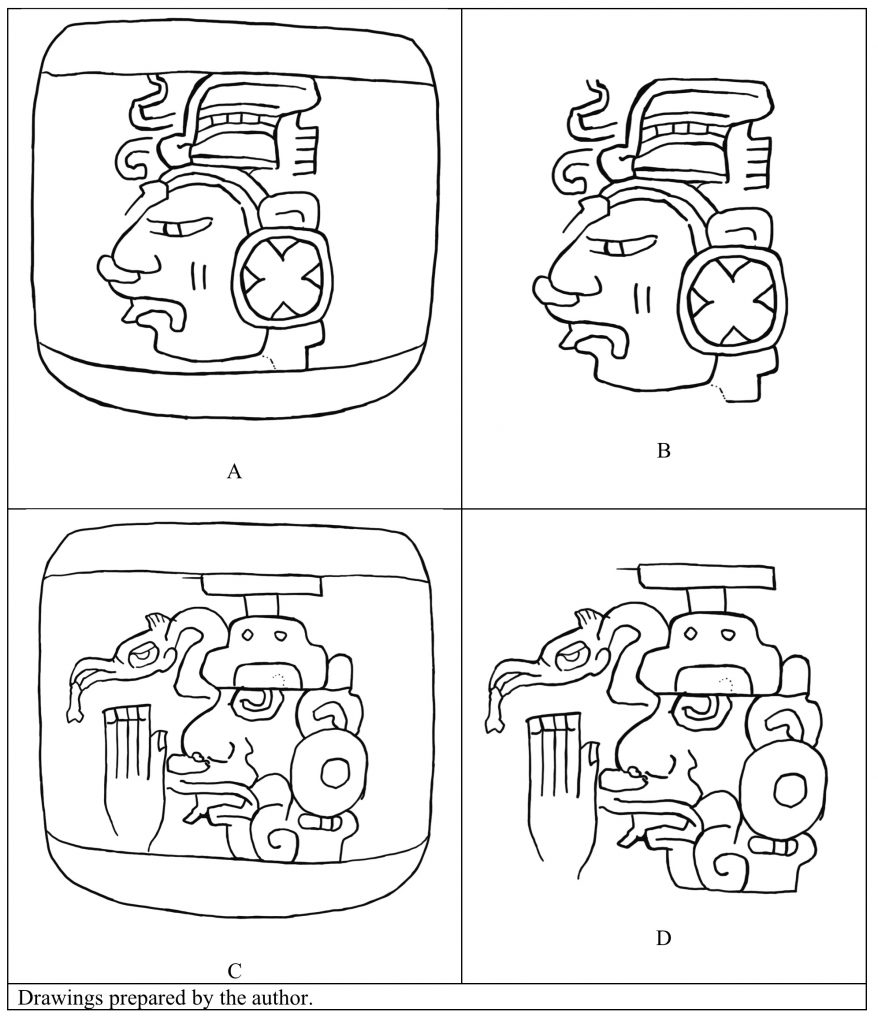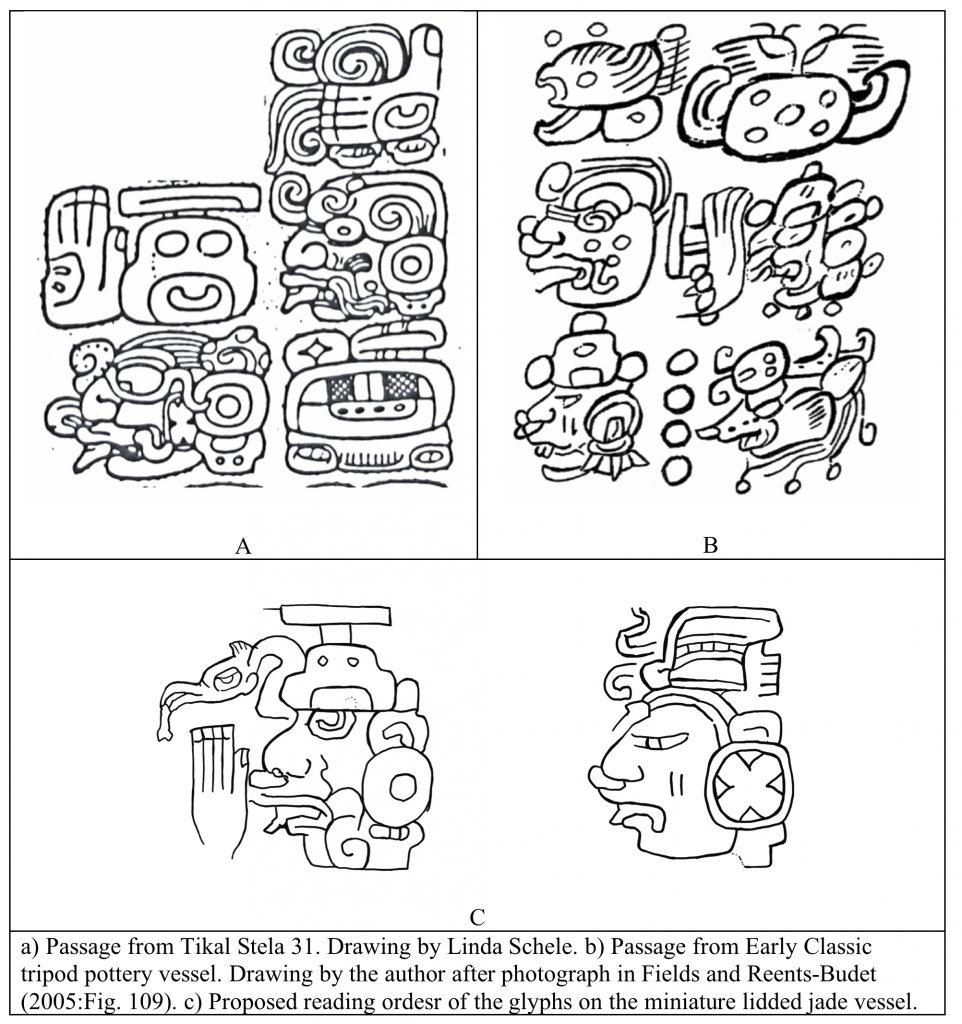A Drawing of the Text on A Miniature Lidded Jade Vessel
David F. Mora-Marín
davidmm@unc.edu
University of North Carolina
Chapel Hill
8/15/2020
This post presents a new drawing of the inscribed glyphs on a miniature lidded jade vessel, about the size of a quarter, housed in a private collection in the United States. One of the glyphs on the vessel was previously illustrated in a blog by Stephen Houston and Alexandre Tokovinine (2013), both in the form of a photograph and a drawing (Houston and Tokovinine 2013:Figs. 1 and 3). Those authors referred to the object as a “bead or hair- or forehead ornament,” but the photos that I have obtained courtesy of Donald M. Hales (Figures 1A-D) make it clear that the object is a miniature vessel with a lid, and that there are two glyphs incised along its circumference, not just one.[i]
Figure 1
Previously, Barbara Kerr prepared a drawing of the vessel and its glyphs, based on a rollout photograph by Justin Kerr; as I do not have a good quality copy of her drawing I prefer not to reproduce it here. I have prepared a set of new drawings myself, seen in Figure 2. These drawings are not as accurate as I would like them to be: the red pigment added to highlight the incisions often obscures the incisions, and also makes the lines seem thicker and more curvilinear than they really are. However, I am confident that they are generally accurate as far as most graphic and stylistic details are concerned.
Figure 2
Regarding the glyph shown in Figures 2A-B, Houston and Tokovinine (2013) remarked as follows: “a K’AWIIL above the head of a human being with K’IN earspool.” I would only add that the individual bears a shark-like tooth, as well as the “II” markings on the cheek that are typically associated with Early Classic versions of PC1/T1000ab. Later, in the Late Classic, scribes began to juxtapose the female head glyph with the IL markings and the one with the II markings. As far as the glyph in Figures 2C-D, there is more to be said. It is a well-known collocation from a wide variety of Early Classic texts (Boot 2002:22), with Figure 3 providing a very selective sample. Interestingly, the example from the miniature jade vessel in Figure 3A includes a component that is typically absent from this collocation: a long-necked bird with a fish (or a bone?) in its beak, reminiscent of the sign discussed by Stuart (2005:37) in connection with the Palenque Temple XIX Panel, which he identifies zoologically as a great blue heron. This detail is a common motif in iconographic portrayals, including the aforementioned Palenque text. Noteworthy is the fact that in such text, as noted by Stuart, the HERON sign with the fish in its beak functions to spell some sort of office. If the example from the miniature vessel is the same sign, albeit an Early Classic version lacking the cross-hatched band across the eye seen in the HERON sign at Palenque, it may refer to such a status or office.[ii] Also worth noting is the fact that the NAH/NOH sign atop the T533 sign in Figure 3A does not need to be always placed in that position, as seen in the corresponding spelling on an Early Classic tripod pottery vessel in Figure 3B, where the NAH/NOH sign precedes the Upright Hand sign and the T533 sign (in its personified version?). This could point, possibly, to a reading NOH-K’AB’ for ‘right hand’, based on the possibility raised by Stuart (2002) in connection to his proposed decipherment of the ‘left hand’ expression, though, I will admit, usually the hand that is depicted in this sign is a left hand, not a right hand. (Then again, Stuart’s ‘left hand’ expression depicts a right hand.) In fact, there is evidence, to be discussed in a future blog perhaps, that suggests that the Upright Hand sign, on its own, could have a value pa, as in the expression UPRIGHT.HAND-PAKAL on K5454, possibly for pa-PAKAL. Figures 3D-C come from Tikal Stela 31 and Tikal Ballcourt Marker, respectively.
Figure 3
I prefer not to go into too much detail right now, except to say that the collocation with the Upright Hand discussed here typically begins a nominal phrase, as in the examples in Figures 4A-B. Indeed, in Figure 4A, the passage from Tikal Stela 31 partly illustrated previously in Figure 3C, obtained from Schele (1989), the Upright Hand phrase spans two glyph blocks, immediately following ya-ʔAL/YAL-la for y-aal ‘he is the child of [woman]’, and thus, the nominal expression beginning with the Upright Hand collocation corresponds to the name of a woman (the mother of Yäx Nun ʔayin). The example in Figure 4B is a passage from the tripod pottery vessel, partly illustrated above in Figure 3B. It follows yu-k’i-b’i ta-2ka-wa for y-uk’-ib’ tä käkäw ‘the vessel for cacao of/for…’; after these glyphs, the name of the intended owner of the vessel begins with the Upright Hand collocation. Note that this text is read right-to-left, instead of left-to-right. This is why the typical Rain God glyph appears to precede the Upright Hand collocation, but in actuality is in its usual position, following it. Given such pattern, wherein the Upright Hand collocation typically constitutes the first component of a nominal phrase, I would suggest that the text in the miniature lidded vessel be ordered as in Figure 4C, with the Upright Hand collocation as the first glyph.
Figure 4
To conclude, it would seem that the entire text on this miniature vessel constitutes a nominal phrase. That said, nominal phrases often include verbal expressions, and can be said to consist of miniature clauses themselves. Further work on decipherment of the Upright Hand sign is needed to elucidate this matter, as my suggestion of a reading as NOH K’AB’ ‘right hand’ should be regarded very tentative.
[i] I would like to express my sincere gratitude to Donald Hales for his time, generosity, and knowledge of Mayan inscriptions.
[ii] Boot (2009:21, 34) identifies the terms b’ak mut and ʔichiw as referring to types of herons in Mayan texts.
References
Boot, Erik. 2002. The Human Hand in Classic Maya Hieroglyphic Writing. http://www.mesoweb.com/features/boot/Human_Hand.pdf
Boot, Erik. 2009. The Updated Preliminary Classic Maya – English, English – Classic Maya Vocabulary of Hieroglyphic Readings. Mesoweb Resources. http://www.mesoweb.com/resources/vocabulary/Vocabulary‐2009.01.pdf.
Fields, Virginia, and Dorie Reents-Budet. 2005. Lords of Creation: The Origins of Sacred Maya Kingship. London: Scala Publishers Limited.
Houston, Stephen, and Alexandre Tokovinine. 2013. REPORT: An Earful of Glyphs from Guatemala. Maya Decipherment: Ideas on Ancient Maya Writing and Iconography. https://mayadecipherment.com/2013/07/14/report-an-earful-of-glyphs-from-guatemala/.
Montgomery, John. 2000. The John Montgomery Drawings Collection. http://research.famsi.org/montgomery.html.
Schele, Linda. 1989. Notebook for the XIVth Maya Hieroglyphic Workshop. University of Texas at Austin.
Stuart, David. 2002. Glyphs for “Right” and “Left”? Mesoweb: http://www.mesoweb.com/stuart/notes/RightLeft.pdf.
Stuart, David. 2005. The Inscriptions from Temple XIX at Palenque: A Commentary. San Francisco: The Pre-Columbian Art Research Institute.



